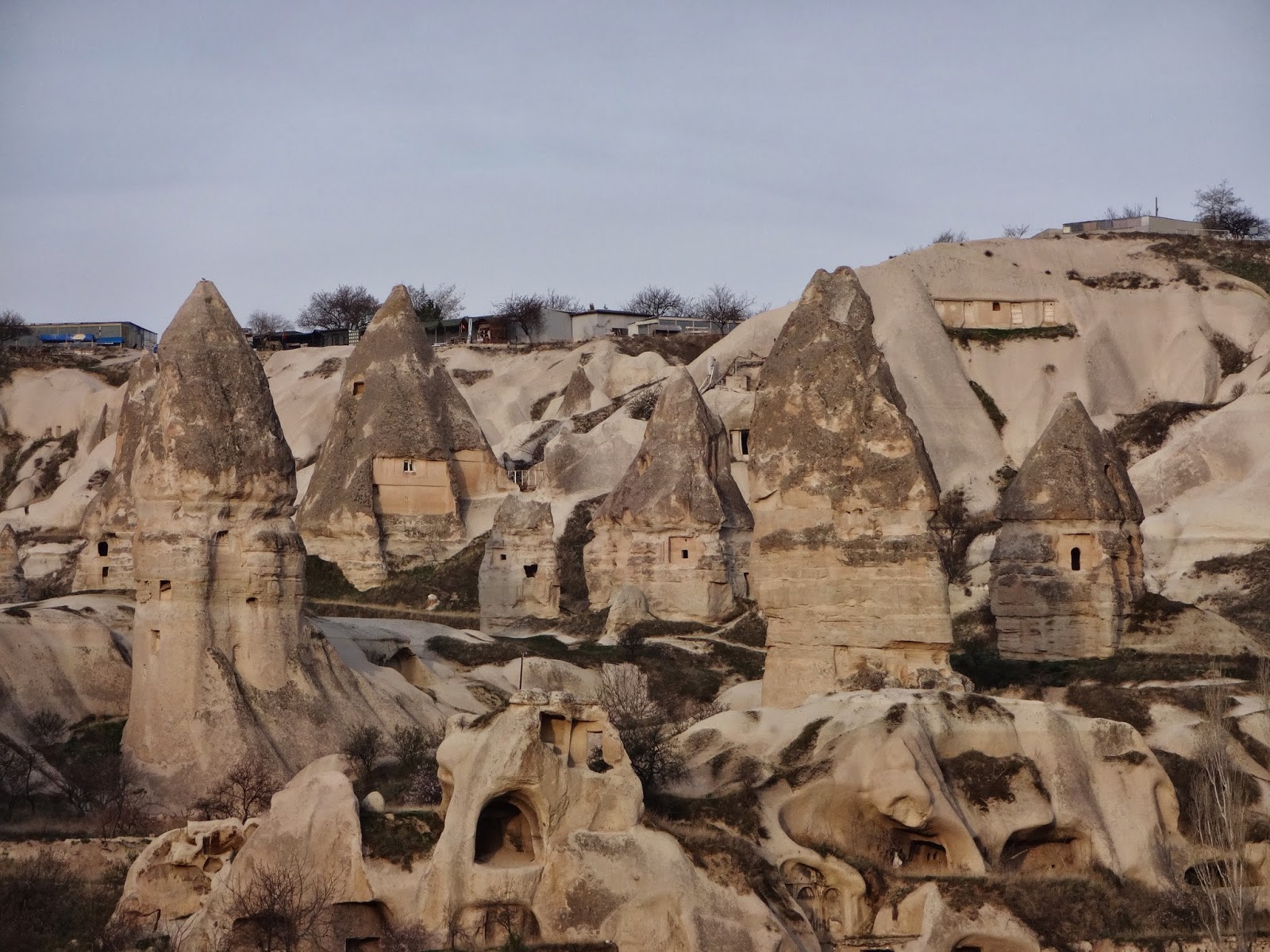Tuesday, March 25, 2014 Goreme
This morning we got up early to watch the hot air balloons on their morning tour. Above is the view from our hotel balcony of the houses carved into the fairy chimneys on the other side of the river valley.
Around 6:30 am the balloons started floating past. Each balloon basket will hold 15 to 20 people. The ride is one hour and usually costs at least $150 Cdn per person. We thought we'd just climb the hill and look down on the valley from there.
After breakfast we embarked on a guided tour of the region south of Goreme. We were in a nice big van with 14 other people, a guide and a driver. At the first stop the guide used these 3 typical, although not big, fairy chimneys to explain how they were formed. Ten million years ago there were at least 3 big volcanoes in the region. They erupted many times so the whole area is composed of volcanic rock. The top layer is very hard, the layer just below that is very soft and the bottom layer is medium hard. Thus, erosion through wind and water formed these cone shapes with hard rock caps.
Our next stop was at Mustafapasa, a former Greek town. The Greeks and Turks used to co-exist peacefully in the area. However, in 1923, a treaty between Turkey and Greece forced all Greeks in Turkey back to Greece and all Turks in Greece back to Turkey. Now this town is Turkish. The Greek churches have become mosques. However, some impressive Greek architecture remains. Anita is turning this small pillar by the side of the door, which, because the building has stayed true, has not become bound in place and will actually spin.
We also stopped at an archaeological dig of a recently discovered Roman village from the 4th century AD. Not much has been excavated yet.
In the Soganli Valley there are numerous churches from the 10th to 13th century, carved out of the rock. This is the "snake" church. In it is a fresco of St. George and St. Theodore slaying a serpent or dragon. The frescos were painted on a fresh plaster made from the egg white of pigeon eggs. It glued the paint in place so it remains there now, unless damaged by vandals.
The church interiors are a bit rough.
This is another church that has pillars carved out of the rock.
We had lunch in this little village in the Soganli Valley. The old ladies from town knit gloves and make beautiful little dolls for sale.
After lunch we went to the Derinkuyu underground city, a World Heritage Site. "City" is actually a misnomer. The Hittites, about 4,000 years ago, dug defensible positions into the rock to use whenever they were attacked. Otherwise they lived at or near the surface of the ground so these weren't really cities. However, there are over 100 of these "cities" that have been re-discovered over the last 50 years. Some of them can hold thousands of people, livestock and supplies to last for months at a time. This one goes 85m deep and has 16 stories, 8 of which are open to the public. Anita went down to the 2nd level below ground and I went to the 8th, although I'm not sure why. It looked the same as the 2nd.
Narrow passages and stairways were deliberately carved out so invaders had to enter one at a time.
Further down, there are bigger rooms. It is believed that tunnels as long as 9 km link some of these underground cities. Impressive.
Every little valley in the region is full of old houses carved out of the cliffs.
This is the Uchisar "Castle", carved out of a mountain.
It was an interesting day. Tomorrow we'll walk through the valleys around Goreme for our own self-guided tour.













No comments:
Post a Comment